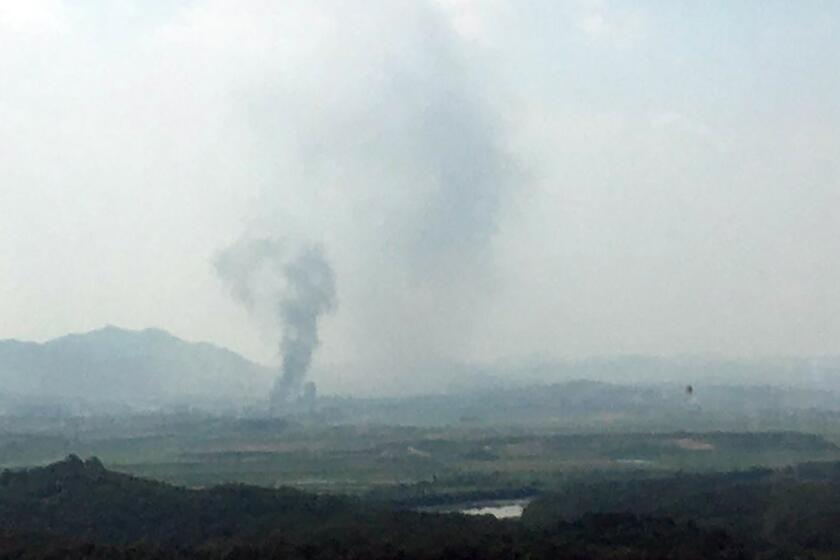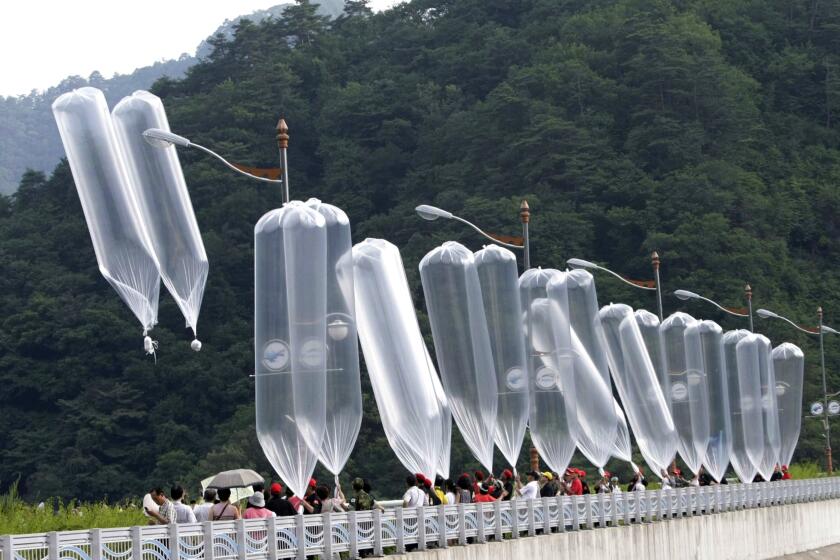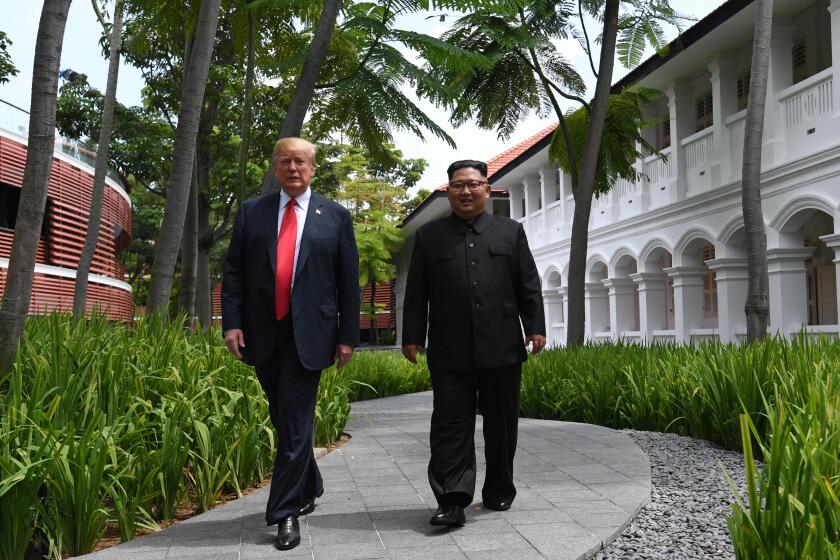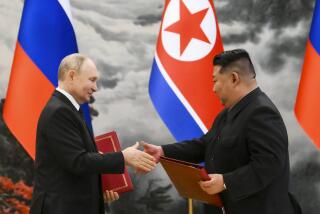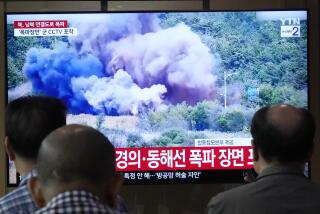North Korea to resume military exercises on border with South Korea
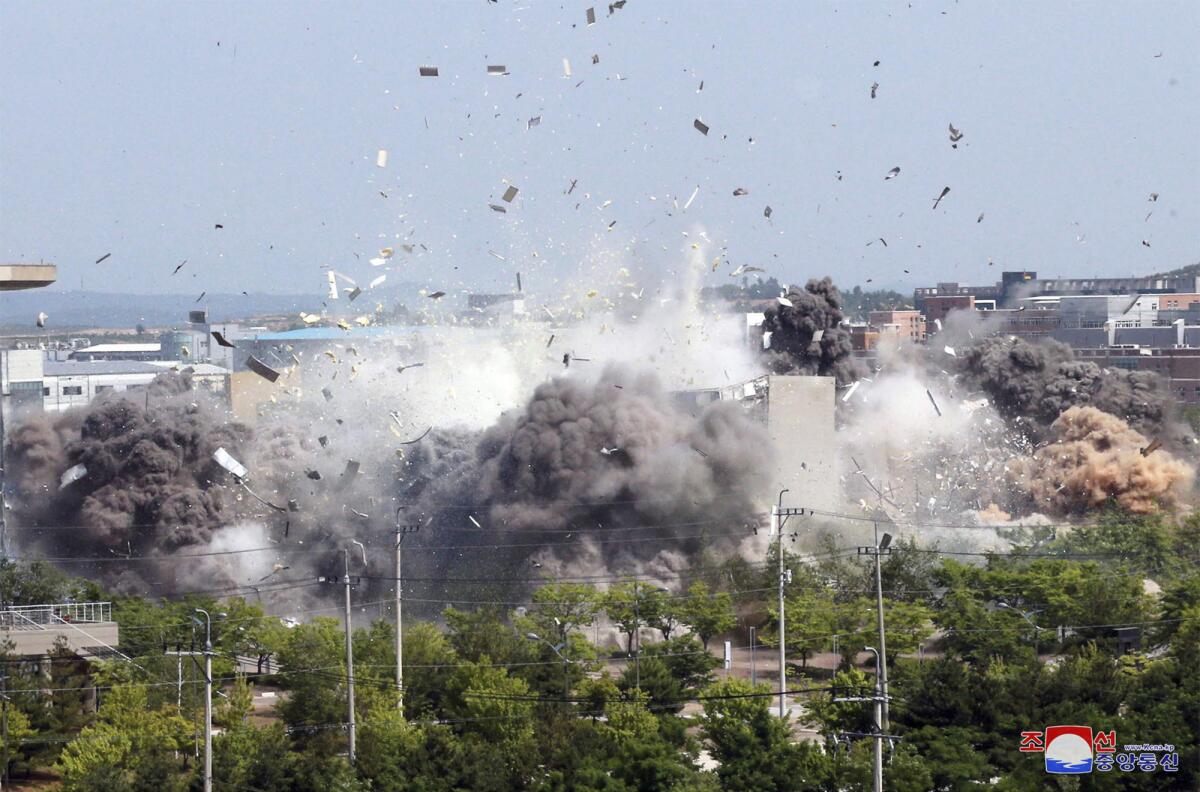
- Share via
SEOUL — North Korea said Wednesday that it will send soldiers to now-shuttered inter-Korean cooperation sites in its territory and reinstall guard posts and resume military exercises at front-line areas, nullifying tension-reducing deals reached with South Korea just two years ago.
The announcement is the latest in a series of provocations North Korea has taken in what experts believe are calculated moves to apply pressure on Seoul and Washington amid stalled nuclear negotiations. On Tuesday, the North destroyed an empty inter-Korean liaison office in its territory.
Though North Korea’s recent actions haven’t led to clashes or bloodshed, it’s still raising animosity on the Korean peninsula to a level unseen since Pyongyang entered nuclear talks in 2018.
The North’s General Staff said military units would be deployed to the Diamond Mountain resort and the Kaesong industrial complex, both just north of the heavily fortified border. The two sites, built with South Korean financing, have been closed for years because of inter-Korean disputes and U.S.-led sanctions.
The North also said it would resume military exercises, reestablish guard posts and boost military readiness in border areas as well as open front-line sites for flying propaganda balloons toward South Korea. Those steps would reverse agreements reached between the Koreas in September 2018 aimed at lowering military tensions along the border.
South Korea’s military expressed regret over the North Korean announcement and warned that the North would face unspecified consequences if it violates the 2018 deals.
Maj. Gen. Jeon Dong Jin at the Joint Chiefs of Staff told reporters that South Korea maintains military readiness and will strive to prevent military tensions from rising. Vice Unification Minister Suh Ho warned against destroying South Korean assets that remain at the two cooperation sites.
North Korea’s destruction of a ‘useless’ inter-Korean liaison office just inside its border with the South has boosted tensions on the peninsula.
Under the 2018 agreements, both Koreas halted live-firing exercises, removed some land mines and destroyed guard posts along the world’s most heavily armed border.
Some experts argued that the moves undermined South Korea’s security more than the North’s as Pyongyang’s nuclear arsenal remained intact.
North Korea will likely next dismantle South Korean-built structures, equipment and other assets at the two cooperation sites before performing military drills and firing missiles and shells toward the sea, said Cheong Seong-Chang, an analyst at the Sejong Institute, a think tank in South Korea.
Cheong said that the deterioration of ties was now “unavoidable” and that South Korea might respond with the resumption of propaganda loudspeaker broadcasts and joint military drills with the United States.
Some analysts see North Korea’s provocations as an attempt to get concessions from Washington and Seoul at a time when its economy, already battered by sanctions, has likely worsened because of the COVID-19 pandemic. They say North Korea may be frustrated because the sanctions prevent Seoul from breaking away from Washington to resume joint economic projects with Pyongyang.
The North’s official Korean Central News Agency on Wednesday said that recent actions were taken to retaliate for South Korea’s failure to prevent activists from floating propaganda leaflets across the border.
South Korea agrees to curb activists from flying anti-Pyongyang leaflets over the border after North Korea threatens to end joint military agreement.
It said the destruction of the liaison building Tuesday was a “reflection of the zeal of our enraged people to punish human scum who challenged the noblest dignity and prestige of our country and those who sheltered the scum, perpetrators of shuddering crime.” It said North Korea would set the intensity and timing for its additional steps while closely monitoring South Korean moves.
North Korea’s state TV showed the scene of the building destruction Wednesday and anchors reading previously published statements on South Korea in an apparent bid to solidify anti-Seoul sentiments at home.
Kim Yo Jong, the powerful sister of North Korean leader Kim Jong Un, separately revealed that North Korea had rebuffed a recent offer by South Korean President Moon Jae-in to send special envoys to Pyongyang to defuse tension.
Kim Yo Jong, who has spearheaded the North’s recent rhetoric against South Korea, called Moon’s offer a “petty farce” and a “trick” to tide over a crisis. She also slammed Moon’s recent urging of North Korea to return to talks and find a breakthrough with South Korea.
In response, one of Moon’s senior presidential advisers, Yoon Do-han, called Kim Yo Jong’s statement “very rude,” “irrational” and “senseless.” Yoon warned that South Korea won’t tolerate similar statements by North Korea any longer, while expressing regret over North Korea’s publicizing of South Korea’s offer to send envoys.
Three summits and many smiling photos later, Trump’s North Korea strategy has the U.S. in a familiar place: an impasse, bracing for provocations.
The exchange of verbal salvos between the Koreas is highly unusual under Moon’s government, which has espoused greater rapprochement with North Korea since taking office in 2017. Moon has faced criticism that he was too soft on North Korea even when it publicly conducted weapons tests targeting South Korea.
South Korea’s top official on North Korea offered to resign to take the responsibility for the tensions. It’s wasn’t immediately known if Moon would accept the offer by Unification Minister Kim Yeon-chul.
Moon, who met Kim Jong Un three times in 2018, was a driving force behind the diplomacy between Pyongyang and Washington, including the first summit between Kim and President Trump in Singapore in June 2018.
Relations between the Koreas have been strained since a second Kim-Trump summit in early 2019 fell apart because of wrangling over the sanctions.
More to Read
Sign up for Essential California
The most important California stories and recommendations in your inbox every morning.
You may occasionally receive promotional content from the Los Angeles Times.
